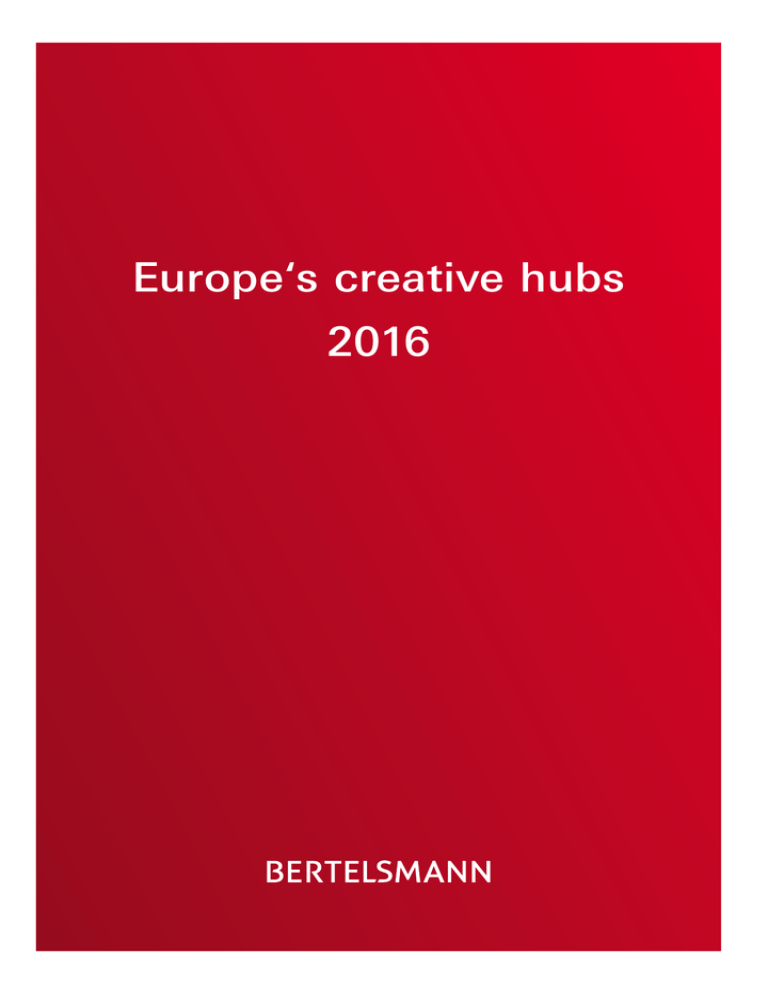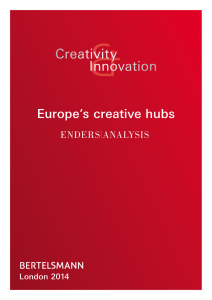
Europe‘s creative hubs
2016
Enders Analysis
Dr Alice Enders and Chris Hayes, economists, are authors of Europe’s Creative Hubs. Enders Analysis is a research and advisory firm based in London, specialising in the media, entertainment, mobile and fixed telecoms industries in Europe, with a special focus on new technologies and media. Enders Analysis supplies its subscribers with over 100 reports annually and clients with bespoke projects. For more information see www.endersanalysis.com or contact info@endersanalysis.com. Copyright © 2016 Enders Analysis. All rights reserved. 1 | 25 Europe’s Creative Hubs Table of Contents Executive Summary ............................................................................................................ 3 Creative consumers ..................................................................................................................................... 3 Creative industries ...................................................................................................................................... 4 Creative jobs ............................................................................................................................................... 5 Challenges and opportunities of digital ....................................................................................................... 5 Creative consumers ............................................................................................................. 6 Media touchpoints ………………….………………………………………………………………………………………………….6 Creative activities ………………….…………………………………………………………………………………………………...8 Perceived importance of the creative industries……….……………………………………………………………………...9 Creative industries ............................................................................................................ 10 Flow of funds for the creative industries ..................................................................................................... 10 Supply-­‐side of the creative industries ......................................................................................................... 11 France ........................................................................................................................................................ 12 Germany .................................................................................................................................................... 13 United Kingdom ......................................................................................................................................... 14 Creative jobs .................................................................................................................... 15 France ........................................................................................................................................................ 15 Germany .................................................................................................................................................... 16 United Kingdom ......................................................................................................................................... 17 Challenges and opportunities of digital ............................................................................... 18 Wider markets ........................................................................................................................................... 18 Challenges and opportunities of digital ...................................................................................................... 19 Appendix I – Defining the creative industries ....................................................................... 20 Appendix II – Sub-­‐markets excluded from our headline figures ............................................. 22 2 | 25 Europe’s Creative Hubs Executive Summary Europe’s top creative hubs of Germany, the UK and France, together produced €135 billion of Gross Value Added (GVA) in 2013 from the efforts of 500,000 enterprises engaged in the production, distribution and retailing of products and services. This includes films, TV programmes, newspapers, magazines and books, as well as design, architecture, advertising and broadcasting. Including not-­‐for-­‐profit and publicly funded arts institutions, the creative industries of Germany, the UK and France, together employed 3.5 million workers and freelancers. Creative talent is at the heart of enterprises in the creative industries. The professional skills of those working in such enterprises shape, nurture and enhance works of authorship to deliver a product or service to the market, offline or online. This talent is drawn from school and higher education leavers, thus tying the dynamism of the creative sector to policies that support education, training and skill acquisition. The creative sector is at the cutting edge of a knowledge-­‐
intensive labour market. Cultural products and services uniquely embody the values of art, identity and dialogue on a plurality of media. Their production cannot be globalised and re-­‐located. Although the opportunities for wider markets due to digital are unparalleled today for media companies, challenges to revenues have arisen from the disintermediation of traditional sales channels and piracy, as well as dependence on online platforms for sales of digital formats. The flow of funds to the creative industries is the most important driver of productive activity. This flow originates mainly with consumers, broadcasters and advertisers in the domestic economy. When media is free-­‐to-­‐view, it generates consumer surplus and advertising revenues for the creative industries, and when it is paid-­‐for, the flow of funds is from consumer expenditure. Sales to tourists and to external markets are also important sources of funds. Piracy, a relatively common behaviour for films, TV programmes, music and books, drains the creative sector. Both expenditure of advertisers and of consumers is strongly influenced by the economic cycle. In keeping with economy-­‐wide macroeconomic trends, the creative industries in Germany, the UK and France showed growth of 15.5%, 27.6% and 0.2% respectively, while their GDP (output measure in current prices) recorded growth of 14.7%, 16.8% and 9.2% in the same period. This shows that the creative industries played an especially dynamic role in the UK’s recovery, and a supportive role in Germany, but lagged wider economic growth in France. Figure 1: GDP and creative hub growth rates 27.6% 30% 25% 20% 14.7% 15% 10% 16.8% 15.5% 15% 15% 9.2% 5% 0.2% 0% GDP/output France Germany UK Aggregate 3 | 25 Europe’s Creative Hubs Creative industries [Source: Enders Analysis and OECD] Creative consumers Millions of consumers view or purchase media for their entertainment or to stimulate literacy and creativity. Creative consumers are of great value to society, even if not directly quantifiable. Exposure to media helps people shape their identities, aspirations and relations to others and the world, at home, at work and on the move. Exploring ideas and issues in detail is critical in the digital age as change accelerates and attention spans diminish. Creative experiences help meet broader societal goals such as participation in democratic processes and promotion of social inclusiveness. In France, Germany and the UK, respectively, consumers regularly engage with a variety of media: • TV is the medium used by almost all consumers in Europe, where it has 97% penetration (at least weekly usage) and audiences watch on average 4 hours of TV programming daily • Listening to music and to radio appeal to most consumers, followed by surfing the internet • Young people concentrate new digital content consumption such as watching videos on YouTube, validating content provider strategies to develop the platform • Half the consumers in the UK and Germany read books, 30-­‐40% of young people regularly do so • ‘Baby Boomers’ and ‘Generation X’ (adults in the age range of 35-­‐65) are prolific magazine readers, especially in Germany, and as these multi-­‐media consumers concentrate disposable income and savings, this should make them a key target for advertisers • Visits to cinemas or cultural events are less frequent than engagement with other media Exposure to media is the reason why so many people regard themselves as creative (Figure 2). This creativity is expressed through hobbies and artistic activity, using media to develop ideas and deepen skills. The wider scope of user-­‐generated content is blurring the line with professional content, providing a deeper pool of creative talent for publishers to nurture. Figure 2: Would you consider yourself a creative person? (%) 73 80 71 63 70 60 50 37 40 27 30 29 20 10 0 Yes France Germany No UK [Source: YouGov] Perceived importance of the media industries Surrounded as they are by the products and services of the creative industries, which is also an important category of consumer expenditure, a very large number of people in France, Germany and the UK appreciate the economic significance of the creative industries. People in Germany are more likely to give them a higher economic importance than in France and the UK. With the increasing overlap between media, online media and creativity, media companies may be expanding in new directions and are viewed by most people across all three countries as at the very least “moderately important” to the greater economy. It is interesting to note that the French, who are most creatively engaged online, and the Germans are more likely than the British, who are the least creatively engaged online, to rank the media industry as “important” (Figure 3). 4 | 25 Europe’s Creative Hubs Figure 3: Perceived economic significance of media industries (%) 100% 8 90% 10 80% 7 5 8 3 24 70% 27 42 60% 50% 46 40% 43 30% 28 20% 10% 14 19 France Germany 9 0% (4) Very Important (3) Important (2) Moderately important (1) Not at all Important UK [Source: YouGov] Creative industries France, Germany and the UK each have relatively high per capita incomes and commensurately high advertiser and consumer expenditure on products and services of the creative sector. For consumers, many products and services fall into “nice-­‐to-­‐have” as opposed to “need-­‐to-­‐have” categories of expenditure, leading to a pronounced cyclical profile. However, there is considerable evidence that subscription models are spreading for audio and video on-­‐demand services, shifting the profile of the home entertainment market from purchasing to subscription. Our summary metrics for 2013 (the latest year of data available on Eurostat) reveal: • Germany is the leading creative hub in Europe, with €52 billion of Gross Value Added (GVA) generated by 138,000 enterprises; this amounts to 3.6% of the non-­‐financial economy in 2013 • The UK is just about level with €51 billion (noting the impact of the sterling/euro exchange rate) generated by 101,000 enterprises, which amounts to 4.8% of the non-­‐financial economy in 2013 • France’s €33 billion of GVA from 191,000 enterprises was 3.7% of the non-­‐financial economy • France, Germany and the UK together generated €135 billion in GVA from the creative industries in 2013, 4% of non-­‐financial GVA of €3,371 billion The UK has the largest creative sector in relative terms: €801 per person in 2013, compared to €649 and €526 per person in Germany and France respectively. Per person domestic consumer expenditure on recreational and cultural services (including TV licence fees) is about the same in the UK as in France and Germany, so the UK’s relatively larger supply-­‐side is explained by the sizeable exports of its audiovisual and advertising groups. UK content travels to markets where English is the first language (the US) or second language (most EU Member States). Economic recovery has helped lift GVA of the creative hubs (Figure 4): • GVA of the UK’s creative industries rose 27.6% over 2009-­‐13 • GVA of Germany’s creative industries rose 15.5% over the same period • GVA of France’s creative industries rose by just 0.2% 5 | 25 Europe’s Creative Hubs Figure 4: Creative industries GVA, 2009-­‐13 (€m) 55,000 49,813 50,000 46,025 44,819 45,000 39,552 38,261 40,000 35,000 32,697 33,995 2009 2010 48,564 44,352 34,389 48,703 51,758 50,478 33,137 32,766 2012 2013 30,000 25,000 20,000 France Germany UK 2011 [Source: Eurostat SBS] Creative jobs National-­‐level reports point to 1.2 million jobs in France (2011), 1.1 million in Germany (2014) and 1.2 million in the UK (2014), although the data are not like-­‐for-­‐like. France and Germany include retailing, while the UK does not on the argument that only ‘creative occupations’ are specific to the sector. Freelancers loom large in the creative industries. In Germany, freelancers account for 25% of jobs in general, and much more in the performing arts. France has designed a specific employment regime for workers with an intermittent pattern of employment to mitigate income insecurity. Challenges and opportunities of digital For creative enterprises, the digital age doesn’t change the large up-­‐front costs and risks of producing content, such as games, films, TV programmes, music and books. Enterprises must also invest to leverage technology and/or to produce content for multi-­‐platform distribution, offline and online. Although authors may more easily self-­‐publish and go direct to consumers, publishers retain their core importance of discovering and nurturing creative talent. Artists and authors benefit from publishers’ expertise across offline and digital platforms of increasing complexity. To date, revenues of producers of audiovisual content have been insulated from the losses experienced by the recorded music group (live events have flourished), with print media steady. TV audiences in Europe remain largely intact, despite the hollowing out of younger audiences. Distribution over the internet provides a new source of revenues for content producers. The EU is aiming to deepen the foundations of online distribution in Europe via the advent of the Digital Single Market (DSM) by 2020. The DSM will revise the policy framework for the digital age, including by ensuring SVOD services are portable for subscribers travelling the EU. The EU is promising one single market comprising 500 million people to creative enterprises and start-­‐ups. In practice, language and culture naturally segment the markets of the 28 EU Member States. Market access also depends on the state of digital enablers, notably the supply and adoption of high-­‐speed broadband access, where there is wide variation among Member States. Cross-­‐
border trade of goods and services has understandably low consumer adoption rates. Shifting to a single market strategy from business strategies optimized on a market-­‐by-­‐market basis could be detrimental to revenues. Europe’s creative hubs of France, Germany and the UK are at the top end of the scale on digital readiness, attracting an ever-­‐growing range of suppliers of digital content to their large, sophisticated and high-­‐spending creative consumers. 6 | 25 Europe’s Creative Hubs Creative consumers Media touchpoints Consumers in France, Germany and the UK, respectively, interact with many media on a weekly basis (Figure 5). Watching TV earns the highest audiences, followed by listening to music or to radio, surfing the internet, reading magazines and books, then watching videos. Germany has the largest share of population of devoted magazine readers, while the UK has the highest share reading books. Germany has lower penetration of watching videos than France or the UK, although this could rise in the future. Figure 5: Engaged with media in past week (% of population) 100 94 97 94 91 88 82 77 80 86 76 78 73 78 62 60 45 40 52 47 40 36 38 39 25 20 4 0 Watch TV Listen to Listen to the Surf the music radio internet France Germany Read Read books magazines Watch videos 0 2 1 1 1 Go to the Attend live cinema events [Source: TNS, Eurobarometer] UK Aside from TV, listening to music appeals to all age groups in France, Germany and the UK, respectively (Figure 6). Channels to enjoy music include radio, music video services like YouTube, freemium and paid-­‐for digital music services, on top of accessing existing music collections on CD players, personal computers or on mobiles through the MP3 function. Figure 6: Listen to music at least weekly (%) 100 98 95 86 81 87 85 80 98 95 95 85 95 95 85 74 67 60 40 20 0 France -­‐ 29 years 30 -­‐ 39 years Germany 40 -­‐ 49 years 50 -­‐ 59 years 60 + years UK [Source: TNS] Relative to France or the UK, magazines are more highly penetrated in Germany in all age groups (Figure 7), with engagement rising with age. 7 | 25 Europe’s Creative Hubs Figure 7: Read magazines at least weekly (%) 76 80 68 61 59 60 42 40 41 53 52 47 44 42 42 43 30 22 20 0 France -­‐ 29 years Germany 30 -­‐ 39 years 40 -­‐ 49 years UK 50 -­‐ 59 years 60 + years [Source: TNS] Baby boomers and Generation X (those 35 to 64) are higher-­‐income on a gross and net (of savings) basis (see Figure 8 for Germany), which should make them of strong interest to advertisers. These consumers have more time to engage with media, maintain ‘modern’ lifestyles and attitudes, continue to spend money on themselves, and are in tune with younger generations in their extensive use of the internet – very different from previous generations. They are especially attractive to brand advertisers and those providing e-­‐commerce solutions for travel, clothing, financial services, etc. Figure 8: Distribution of income in Germany, 2012 50,000 43,900 45,000 43,730 4000 43,390 3500 40,000 3000 35,000 27,870 30,000 28,870 27,840 26,950 21,830 25,000 20,400 10,000 22,190 16,800 20,000 15,000 2500 27,660 10,210 9,160 2000 1500 1000 500 5,000 0 0 16-­‐24 25-­‐34 35-­‐44 Gross income (annual) Net income (annual, self-­‐assessment) Net savings amount (annual) 45-­‐54 55-­‐64 65-­‐74 75+ [Source: Deutsche Bundesbank household survey] Reading books is undertaken by half the population of each of Germany and the UK, and closer to one-­‐third in France (Figure 9). Engagement with books – and print media in general – is critical to maintaining literacy levels in younger generations. 8 | 25 Europe’s Creative Hubs Figure 9: Read books at least weekly (%) 80 60 40 32 50 44 38 31 41 48 48 54 48 56 60 50 40 31 20 0 France -­‐ 29 years Germany 30 -­‐ 39 years 40 -­‐ 49 years UK 50 -­‐ 59 years 60 + years [Source: TNS] In relation to watching TV, viewing videos emerges as a very popular activity among young people, less so among older age groups (Figure 10). Media companies are adapting to audience expectations on YouTube, while also preserving audiences for traditional media and platforms. Figure 10: Watch videos at least weekly (%) 90 81 80 66 64 70 60 46 50 45 40 31 30 25 23 14 20 43 22 20 11 10 18 9 0 France -­‐ 29 years 30 -­‐ 39 years Germany 40 -­‐ 49 years 50 -­‐ 59 years UK 60 + years [Source: TNS] Creative activities Books and magazines, served in print or apps, stimulate creative activities, such as decoration, handicrafts or gardening (Figure 11). Artistic activities like painting, photography, playing an instrument etc. occupy about one-­‐third of consumers in the coverage countries, slightly more in Germany. Artistic activity of this kind is more widely adopted than creative activity on the internet. For society as a whole, consumers’ interactions with media are central to shaping self-­‐identity, interests, and skills. Media is just as important as it ever has been in fulfilling less tangible goals of society, such as values of tolerance and inclusiveness, freedom of speech and political participation.i Educator Mitchell Resnick argues creativity has never been more important to our economic future than today: “In today’s rapidly changing world, people must continually come up with creative solutions to unexpected problems. Success is based not only on what you know or how much you know, but on your ability to think and act creatively. In short, we are now living in the Creative Society.”ii These creative activities are also good for society, to help creative people stay creative, at home and at work. This helps explain why so many people, the overwhelming majority in France, Germany and the UK, see themselves as creative (see Figure 2 in Executive summary). 9 | 25 Europe’s Creative Hubs Figure 11: Creative activities engaged with in past week (%) Decoration, handicrafts, gardening 61 27 Artistic activities like painting, sculpture, ceramics, playing an instrument, singing, ballet or theatre dancing 33 20 Creative activities on the internet by using the Social Media for blogging, posting your own content or… 11 Written a text article, a book or a poem None of these 13 0 France Germany 17 10 68 74 37 26 28 24 20 22 20 30 40 50 60 UK 70 80 [Source: TNS] Growth of online creative engagement The Internet provides a growing area for creative engagement and inspiration. A myriad of activities are in evidence such as ordering personalised gifts,compiling photo albums, extending to uploading photos to platforms like Instagram and Pinterest. Social networks are a profound source of inspiration to many people as they are encouraged by their peers to express their creative potential through photos, videos, poetry and commentary. YouTube and other video-­‐hosting platforms both inspire and are an outlet for user-­‐generated content, and also semi-­‐professional video creators, there being a continuum of video creation. People in France, Germany and the UK are comfortable personalising items and creating personal products online, and many people in France are actively creating blog posts and editing videos as well (Figure 12). Figure 12: Creative activities ever done online (%) 36 39 Personalised and ordered a gift 43 43 Edited and uploaded images Compiled a photo book online 20 21 18 19 Created / edited and uploaded videos Published a blog article Edited music 7 Furnished a virtual room 7 Shared a recipe in an online cookbook 6 12 15 12 15 0 Germany 24 23 26 6 3 4 Don't know / No answer 10 UK 50 14 15 15 17 None of the above France 28 30 47 20 30 32 40 50 60 [Source: YouGov] People are also using the Internet as a source of instruction as the survey from YouGov reveals: • 46% of France’s internet users occasionally use tutorials, 9% regularly doing so • 35% of Germany’s internet users occasionally use tutorials, 5% regularly doing so • 34% of the UK’s internet users occasionally use tutorials, 4% regularly doing so 10 | 25 Europe’s Creative Hubs Creative Industries Flow of funds to the creative industries Total funding made available from private market sources for the creative sectors in France, Germany and the UK, respectively, consists of: • Expenditure by consumers on products and services of the creative industries, whether on TV licence fees, pay-­‐TV and Video-­‐on-­‐demand (VOD) events and subscriptions, tickets for the cinema and live events, and purchases of media, online or offline • Business expenditure on advertising on TV, radio, print media and online, and on purchases of related services from advertising and marketing agencies • Broadcaster and studio funding of audiovisual productions, also benefitting from subsidies (e.g. film tax credits for works of cultural significance) • Exports of creative products and services to external audiences (other EU Member States, US, emerging markets), rising for English-­‐language productions and formats The creative industries also comprise not-­‐for-­‐profit and publicly-­‐funded arts institutions such as museums, libraries and public sector broadcasting. Historically, relatively high expenditure of consumers on recreation and culture coincides with relatively high incomes, since many cultural products and services fall into “nice-­‐to-­‐have” as opposed to “need-­‐to-­‐have” categories of expenditure. The UK had the highest level of consumer expenditure per capita on recreation and culture at €2,182 in 2014, up by 19% since the trough of 2009 (Figure 13). One driver has been rising expenditure on services, which includes live sports and arts events, TV licence fees, pay-­‐TV and other subscription services. These services have also been a driver for the growth of Germany’s per person expenditure since 2009, up 10% to reach €1,781 in 2013. In both the UK and Germany, expenditure on audiovisual equipment, such as TV sets, video equipment, computers and the like, has been stable along with spend on print media (newspapers, magazines and books). Print media attracts significant per person consumer expenditure in Germany, 40% higher than in the UK. France’s declining expenditure on recreation and culture reflects the wider on-­‐going economic malaise. Figure 13: Household spend on recreation & culture, 2008-­‐14 (€ per capita) 2,500 2,000 1,500 1,000 500 0 DE FR UK Total 2008 2009 2010 DE FR Recreational & cultural services 2011 2012 11 | 25 Europe’s Creative Hubs UK 2013 DE FR UK Audiovisual equipment 2014 DE FR UK News, books and stationery DE FR UK Other [Source: OECD] Supply-­‐side of the creative industries The definition of the creative industries used in this report follows the prevailing continental European methodology of aggregating the activity groups of: print media, consisting of the publishing, printing and retailing of newspapers, magazines and books; audiovisual, which is the recording, production, broadcasting and retailing of audio and audiovisual works; advertising; and other. Annex I contains the full details. This definition does not match that produced by the responsible ministries of France, Germany and the UK, respectively. The gap is especially large in relation to the UK’s Department of Culture, Media and Sport (DCMS), which includes the group comprising “IT, software and computer services”, which contributed 44% of the cluster’s GVA in 2014.iii DCMS also includes the public broadcasting corporations, BBC and Channel 4, the bedrock of the UK’s audiovisual production sector. By contrast, Germany’s Federal Ministry of Economics and Technology (BMWi) includes only private-­‐sector activity in its definition, excluding public service broadcasting, museums, etc. These distinctive definitions make it impossible to use nationally produced data in order to make like-­‐for-­‐like comparisons on the supply-­‐side of the creative industries. This report relies on Eurostat’s SBS database for the contribution to Gross Value Added (GVA) or GDP of the enterprises primarily engaged in the supply of creative products and services. These data are collected through business surveys and are unlikely to include entities in the public sector. This is a limitation since, from an industrial perspective, the private and public sectors both contribute to the health of the creative industries and the pursuit of quality in output that drives audience engagement. In Germany, the top creative hub in Europe in absolute terms, the creative industries generated GVA of €51.8 billion (Figure 15), equivalent to 3.6% of the non-­‐financial economy. This was just ahead of the UK’s creative industries with GVA of €50.5 billion, equivalent to 4.8% of the non-­‐
financial economy. Despite a similar-­‐sized population, France’s creative industries generated just €32.8 billion in GVA in 2013, representing 3.7% of the non-­‐financial economy. Figure 15: Performance of industry groups, 2013 Germany France UK GVA (€m) No of enterprises GVA (€m) No of enterprises GVA (€m) No of enterprises Print media 20,314 34,997 9,650 55,830 18,060 26,926 Audiovisual 13,410 18,241 11,020 45,005 12,059 31,040 Advertising 9,532 26,329 7,180 25,274 12,196 18,242 Other 8,502 58,072 4,915 64,640 8,164 34,736 Creative industries 51,758 137,639 32,766 190,749 50,478 110,944 Group [Source: Eurostat SBS]
Germany’s largest group is print media, with €20.3 billion in GVA. The UK is second-­‐placed on print media, with €18 billion in GVA in 2013. Despite a larger population, France’s print media group is less than 55% of the level of the UK, lacking the same sizeable potential to export. However, the group boasts a much higher number of enterprises in France than in Germany or the UK, in keeping with the tradition of small publishing houses, numerous independent book stores and newsstands. 12 | 25 Europe’s Creative Hubs Germany’s audiovisual group was worth €13.4 billion, larger than France and the UK, although smaller in per capita terms due to Germany’s population of 80 million. France and the UK each have much larger numbers of enterprises than Germany, perhaps reflecting the proliferation of independent SMEs supplying broadcasters and studios. The UK’s advertising group was worth €12.2 billion in GVA, more than France or Germany, noting the importance of exports by enterprises headquartered in the UK from which they serve Europe and outlying areas. This allows enterprises to reach an average scale in the UK that far surpasses that attained in France or Germany. Looking at the performance of the creative industries during 2009-­‐13: • The UK’s creative industries recorded the fastest pace of growth of GVA, up by 28% over 2009-­‐13 • Germany’s creative industries’ GVA rose at 15.5% over the same period • France’s GVA has risen by just 0.2% Clearly, the core driver of the fate of the creative sector is the state of the domestic economy, followed by external demand, where relevant. France The creative industries of France have historically been considerably smaller than German and British counterparts. This gap has widened since 2011 owing to the persistence of the country’s wider economic malaise, negatively impacting the cyclically-­‐exposed advertising group and consumer expenditure on media. After an encouraging 4% resurgence in GVA in 2010, subsequent years eroded those gains once more, with €32.8 billion in GVA in 2013 (€526 per capita) below the 2011 level of €34.4 billion, and a largely flat level of GVA on balance as a result (Figure 16). The largest absolute declines during the period were in physical printing, newspaper publishing (and periodicals), advertising, and, to a lesser extent, audiovisual production and post-­‐production. Figure 16: France's creative industry clusters, GVA (€m) 12,000 11,000 10,000 9,000 8,000 7,000 6,000 5,000 4,000 2009 Print media 2010 AV 2011 Advertising 2012 Other* 2013 [Source: Eurostat SBS] With €9.7 billion value added, print media is less central to France’s creative industries than to German and British counterparts. Having fallen in value by 10% between 2010 and 2013, print media has been eclipsed by the audiovisual group, worth €11.0 billion in GVA in 2013. In this group too, however, the robust growth of 2008-­‐11 has been followed by stagnation. The last available assessment of jobs in the creative industries by the authorities in France revealed a total of 1.2 million jobs in 2011 (see below). 13 | 25 Europe’s Creative Hubs Germany Germany’s creative industries generated €51.8 billion in value added in 2013 (€649 in value added per capita) and comprised 138,000 enterprises. The largest group is print media (Figure 17), with GVA of €20.3 billion, although this has been steadily eroded (2010-­‐13 CAGR was -­‐1.5%), by similar structural problems to those in other markets. The audiovisual sector was worth €13.4 million in 2013, and has been demonstrating muscular growth at 9.1% CAGR over 2010-­‐13. Advertising suffered from the recession, but has recovered healthily, and in 2013 accounted for €9.5 billion in value added. Germany’s other creative industry groups were worth €8.5 billion in 2013. Figure 17: Germany's creative industry clusters, value added (€m) 23,000 21,000 19,000 17,000 15,000 13,000 11,000 9,000 7,000 5,000 2008 2009 Print media AV 2010 Advertising 2011 Other 2012 2013 [Source: Eurostat SBS] Germany’s creative industries have on the whole outperformed the nominal growth of GDP over the period 2011-­‐13, after having underperformed in 2010 (Figure 18). The Federal Ministry for Economic Affairs and Energy (BMWi), which produces annual reports on the cultural and creative industries, indicates 1.1 million jobs in 2014 (see below).iv Figure 18: Germany's nominal GDP vs creative industries' value-­‐added, growth (%) 14.0% 12.0% 10.0% 8.0% 6.0% 4.0% 2.0% 0.0% -­‐2.0% Nominal GDP Print media AV Advertising Other Total -­‐4.0% 2010 2011 2012 2013 [Source: Eurostat SBS] 14 | 25 Europe’s Creative Hubs United Kingdom The UK is the most fertile of Europe’s creative hubs, with value added of €801 per capita in 2013, 23% ahead of Germany’s €649. Despite flat-­‐lining for the last few years, the print media group is still the single most important one in 2013 (Figure 19). The UK’s advertising market is highly developed, and total value added grew by 32% in 2013 (constant currency basis); per capita value added in 2013 was €194, 62% greater than in Germany. The UK has the largest AV sector at €191 per capita (€177 for France and €168 for Germany). The UK benefits from robust demand for English-­‐language content in Europe, where 38% of adults claim conversational abilityv, and in other export markets. Growth since 2011 of the AV sector stalled. Growth in architecture and design activities has been strong. Figure 19: UK's creative industry clusters, value added (€m, 2013 fx rate) 20,000 18,000 16,000 14,000 12,000 10,000 8,000 6,000 4,000 2008 2009 Print media 2010 AV Advertising 2011 2012 2013 *2009 partly interpolated due to missing data Other [Source: Eurostat SBS] Growth over 2010-­‐13 (CAGR on a constant currency basis) was 9%, compared with 3% for nominal GDP (Figure 20), noting that 2013 was a flat year for audiovisual, as previously noted. Figure 20: UK's nominal GDP vs creative industries' value added, growth (%) 50.0% 40.0% 30.0% 20.0% 10.0% 0.0% -­‐10.0% Nominal GDP Print media AV Advertising Other Total -­‐20.0% -­‐30.0% 2009 2010 2011 2012 2013 15 | 25 Europe’s Creative Hubs [Source: Eurostat SBS] Creative Jobs To complete the picture of the creative economies of France, Germany and the UK, this section compiles data on employment published by official sources in those countries, noting that each regulator has a distinct approach to defining the scope of the sector (see Appendix I). When looking at employment in the creative industries, jobs held down by employees or freelancers in the non-­‐commercial segments of the sector also need to be included. Public service broadcasting, publicly-­‐funded museums and arts institutions for example are not included in the business surveys conducted by Eurostat for its SBS Database. The European Cluster Observatory noted in their study of regional employment in the cultural and creative industries that Germany’s is spread quite evenly throughout the national territory. Those of France and the UK are concentrated in and around Paris and London, respectivelyvi. France France was estimated to have 1.2 million people engaged in its creative and cultural industries in 2011, representing 5% of total employment of the economyvii. Graphic and plastic arts are the single largest employer with over 300,000 persons (Figure 21), followed by live performing arts and music. France has a specific regime for its “intermittents du spectacle”, by definition artists or technicians that work intermittently on film productions, the audiovisual and the live-­‐performing industries and artist-­‐performers. Figure 21: Employment in creative industries, France, 2011 Press/Newspapers and magazines, 101,933 Book industry, 79,613 Video games, 23,635 Radio, 17,450 Graphic and plastic arts, 307,716 Television, 176,467 Music, 240,874 Cinema, 105,890 Live performing, 267,713 [Source: EY2013] 16 | 25 Europe’s Creative Hubs Germany The Federal Ministry for Economic Affairs and Energy (BMWi) reported that jobs in the private sector of the ‘cultural and creative industries’ (CCIs) totalled 1.1 million jobs in 2014 (Figure 22), rising to a total of 1.6 million if occasional workers are included.viii The software and games industry is the biggest single employer with 338,000 jobs involved, a group that has added close to 100,000 jobs since 2009. Architecture and design groups have also added jobs since 2009. BMWi tracks the number of ‘artists’ in each segment that is ‘own-­‐account’, i.e. working on their own. Freelance work is prevalent for the creative industries (24% of the total) in relation to other sectors in Germany, and is acute in the art market (69% are freelancers), performing arts (45%) and film markets (32%). (BMWi does not report significant freelance activity in the software and games industry or in design.) Figure 22: Employment in creative industries, Germany, 2014 Art market, 18,391 Performing arts market, 38,802 Broadcasting industry, 41,828 Music industry, 47,798 Other, 15,302 Film industry, 60,348 Software and games industry, 338,136 Book market, 76,156 Architecture market, 113,218 Design industry, 137,959 Press market, 152,213 Advertising market, 140,665 [Source: BMWi] 17 | 25 Europe’s Creative Hubs The UK The Department for Culture Media & Sports (DCMS) defines the creative industries as those making intensive use of people in ‘creative occupations’.ix DCMS excludes activities such as distribution and retailing (unlike France and Germany) which, although are critical to the revenues of groups comprising the creative sector, although not ‘creative occupations’ as such. DCMS includes all IT, software and computer services, unlike Germany (just software) or France (just games), leading UK policymakers to focus on promoting Science, Technology, Engineering and Mathematics (STEM) subjects in education to supply the skills base of the industry. According to DCMS, the UK had 1.8 million directly employed in the creative industries, of which 33% were employed in the IT, software and computer group alone (Figure 23).x Without this group being included, the UK had 1.2 million jobs in the creative industries. Figure 23: Employment in creative industries, UK, 2014 Museums, galleries and libraries, 85,000 Architecture, 101,000 Design: product, graphic and fashion design, 136,000 IT, software and computer services, 607,000 Advertising and marketing, 167,000 Publishing, 193,000 Music, performing and visual arts, 285,000 Film, TV, video, radio and photography, 228,000 [Source: DCMS] Creative jobs have a high concentration in and around London: 11% in London and 7% in the South East, lifting the whole UK average share above all other regions, at 6%. It also merits notice that the creative industries’ share of employment jobs in a given region has been highly correlated with the strength of that region’s economic recovery, in terms of both output and especially employment. Importantly, creative jobs are also notably more skewed than average towards higher qualifications. DCMS reports that 59% of workers within the creative industries have a degree or equivalent qualification, compared to 31% in the UK economy. Qualifications are in marked evidence in the groups of architecture, advertising, publishing and audiovisual. This places the creative industries at the higher end of an increasingly globalised labour market. The Employer Skills Survey 2013 reported that the creative industries were on balance more likely than others to recruit someone who had only recently left education, thereby providing a valuable route for young people into the labour market (although they were also marginally less likely to have recently provided training to employees). 18 | 25 Europe’s Creative Hubs Challenges and opportunities of digital Media companies in Europe’s creative hubs fully recognise the internet is an additional channel to reach consumers, alongside offline retailing and broadcasting channels. The promise is of wider and deeper national markets, as well as realizing cross-­‐border transactions, where feasible. Enterprises have sought to realise the ‘digital dividend’ in relation to physical formats. There are however a myriad of countervailing pressures, including lower prices of digital formats on online platforms in the case of e-­‐books, as well as increasing demands for “equitable remuneration” from authors and their lobbies. These have eroded the size of the digital dividend. Publishers must maintain both physical and digital distribution. While some consumers are at the forefront of digital, older people, even though connected regularly for email, news and e-­‐
commerce, may be fully satisfied with ‘offline’ discovery and physical formats. Book readers often relate the joys of browsing the bookshop, an experience that is not replicable online. News, magazines, books, music and video – each of these content forms has a distinct digital destiny, despite their commonalities, and present different challenges and opportunities to publishers. Publishers remain at the core of the industry since they discover authors and nurture their projects through advances. They also provide often crucial editing services, translation, and marketing and distribution expertise across both offline and digital channels. They sustain the key relationships with retailers, e-­‐tailers and platforms like Amazon, Apple and Google. For an author to assume the multiple roles a publisher undertakes would be costly and, more importantly, take away from the time that could be devoted to creative activity. Wider markets The main opportunity for e-­‐commerce sales today for creative businesses is national. In 2015, when 50% of consumers in the EU on average had purchased online in the past year, just 16% had purchased from another EU territory on a cross-­‐border basis.xi Consumers in small countries (e.g. Luxembourg) or in linguistic areas tend to order cross-­‐border much more than those in large and well-­‐supplied e-­‐commerce markets such as France, Germany or the UK (Figure 24). Figure 24: Cross-­‐border consumer e-­‐commerce, 2015 (%) 80% 70% 60% 50% 40% 30% 20% 19 | 25 Europe’s Creative Hubs UK Spain Sweden Slovenia Slovakia Romania Portugal Poland Netherlands Malta Luxembourg Lithuania Italy Latvia Ireland Greece Hungary Germany France Finland EU 27 Estonia Denmark Cyprus Czech Republic Croatia Bulgaria Belgium 0% Austria 10% [Source: Eurostat] These differences across the 28 Member States reflect the drivers of e-­‐commerce enablement: • Wide access to high-­‐speed fixed-­‐line and/or mobile data networks , and the devices and skills to use technology effectively • Trust in online commerce, such as standards for truthful advertising and marketing, contractual arrangements, including the right to return a good; enforceability of contracts and rule of law • Comfort in transacting with online merchants serving the home market from an external location, including the linguistic skills to navigate websites and contractual conditions • Reliable online payment solutions for B2C sales (cross-­‐border sales require either a common currency or a payments solution that provides low-­‐cost currency exchange) • Frictionless, low-­‐cost delivery including cross-­‐border • Distribution platforms for sales of goods (Amazon), applications and digital content files (iTunes, Google Play, Amazon); search engines (Google); intermediaries and hosting platforms for streaming music and video content (YouTube) • Free access for audiovisual OTT services to the end-­‐customer via ISP services (requiring Content Delivery Networks (CDNs) and “net neutrality”) • Publisher ability to monetize online sales of content in relation to theft of intellectual property rights (copyright, trademarks and designs) Policy enablers Many of the core enablers of the digital age are the subject of European and national multi-­‐sectoral policy initiatives designed to unlock the potential of the digital economy for everyone, often directed first at delivering the basic building blocks of high-­‐speed broadband networks and e-­‐skills. Barriers to cross-­‐border commerce are being addressed by the Commission. The reform to the VAT regime at the start of 2015 eliminated the distortion favouring online merchants established in certain locations.xii The European payments area initiative and minimum standards for consumer protection in online transactions in all Member States will deepen e-­‐commerce. The EU regards over-­‐the-­‐internet (OTT) distribution as allowing a more integrated Single Market that could lead to scale EU companies being established. The Commission is addressing ostensible barriers via the Digital Single Market (DSM) initiative, whose advent is set for 2020, claiming the addition of €415 billion annually to the EU economy and hundreds of thousands of new jobs. The DSM is a complex project, spanning the integration of communication networks, notably mobile, harmonisation of the EU’s regime for personal data protection, e-­‐commerce and cross-­‐
border access to audio-­‐visual media services, as well as online platforms. EU competition authorities are investigating the contracts between the six major Hollywood studios and leading European pay-­‐TV operators.xiii With such a high level of activism on the legislative and competition policy fronts, it is difficult to predict at this juncture the changes the EU will actually make to achieve the DSM. It is to be hoped that the changes implemented will further support the EU’s creative industries. By 2020, the Commission promises one digital single market comprising 500 million people will be available to creative enterprises, digital and tech start-­‐ups. In practice, language and culture naturally segment the markets of the 28 EU Member States, along with many other factors of relevance to companies considering serving them through digital means, such as the state of the fixed-­‐line networks critical to delivering AV content. Print media offered for sale in the home market does not require translation, but invariably does when sold to another market. The Commission’s own evidence is that Europeans watching films do so either in their native tongue, dubbed or subtitled.xiv The brisk trade in formats indicates demand for ‘versioned’ entertainment shows. Music travels across the borders of the EU Member States more easily than books or videos, although domestic artists are often preferred by audiences. 20 | 25 Europe’s Creative Hubs Appendix I – Defining the creative industries Enders Analysis definition To define the creative industries, this report follows the prevailing continental European methodology of aggregating the activity groups of: print media, consisting of the publishing, printing and retailing of books, newspapers and magazines; audiovisual, which is the recording, production, broadcasting and retailing of visual and musical works; advertising; and other. The approach in this report is to focus on the commercial side of the creative industries. The analysis therefore does not cover the large segment – notably public broadcasting, the preservation of cultural heritage, much of the performing arts – that lies outside the private sector because it is not-­‐for-­‐profit, publicly-­‐owned and/or funded by licence fees, grants or donations. It should however be clear that the commercial activity in the creative industries does rely on significant public-­‐private interactions. Another constraint on the cross-­‐country analysis of the creative industries is the scope of the data made available by Eurostat in the Structural Business Statistics (SBS) database. This database contains like-­‐for-­‐like data on enterprises (excluding micro-­‐enterprises), their employment (but not freelancers), turnover, contribution to GVA, and so on, for each EU Member State. This database, which relies on business surveys in EU28, covers the manufacture, production and distribution of products and services of the creative industries, excluding the business side of the performing artsxv. This may be because the performing arts are highly reliant on public funding and donations by individuals and companies, along with ticket and merchandise sales. Table A.1 – Definition of the creative industries Sector NACE Rev 2 code Printing and reproduction of recorded media 18.1, 18.2 Retail sale of books, music and newspapers (in specialised stores) Publishing activities 47.61, 47.62, 47.63 58 Motion picture, video, and television programme production 59.1 Sound recording and music publishing activities 59.2 Programming and broadcasting activities 60 Architectural and engineering activities; technical testing and analysis 71 Advertising and market research 73 Other professional, scientific and technical activities 74 Creative, arts and entertainment activities 90 [Source: Enders Analysis based on SIC(2007)] UK government definition The Department for Culture Media and Sports (DCMS) defined the creative industries in 1998 as those industries which ‘have their origin in individual wealth and job creation through the generation and exploitation of intellectual property’. This distinguishes the creative industries from cultural industries, which are not primarily defined by their economic value, but by their contribution to society in promoting identity, shared values and a common idiom, alongside individual creativity. 21 | 25 Europe’s Creative Hubs Recently, DCMS has adopted a definition of the creative industries based on their common trait, which is a relatively intense use of workers in creative occupations.xvi These are grouped into 9 groups: advertising and marketing; architecture; crafts; design; film, TV, video, radio and photography; IT, software and computer services; publishing; museums, galleries and libraries; music, performing and visual arts. The inclusion of ‘IT, software and computer services’ is controversial insofar as neither France, Germany nor the European Commission have chosen to follow this approach. Some salient differences: Unlike ESSnet, DCMS does not include in its definition the retailing of media DCMS has included the entire sub-­‐market of software publishing (section 62), not just entertainment software DCMS reported in January 2016 that the creative industries accounted for gross value added (GVA) of £84 billion in 2014, representing 5.2% of the UK economy.xvii DCMS estimated the creative industries accounted for 1.8 million jobs directly (5.6% of total jobs). The creative industries are a major export earner, with £17 billion (8.8% of total UK exports of goods and services) in 2014. •
•
German government definition The Federal Ministry for Economic Affairs and Energy (BMWi) began reporting on the ‘cultural and creative industries’ (CCIs) in 2009, defined to encompass 12 sub-­‐markets.xviii These are: music industry; book market; art market; film industry; broadcasting industry; performing arts market; design industry; architecture market; press market; advertising market; software and games industry; and other. Each set of data on jobs, companies, turnover and GVA contribution include all aspects of the manufacture, production and distribution of products and services, including the retailing of books, music, newspapers and magazines, as well as films. BMWi clarifies that the coverage includes market-­‐focussed enterprises and excludes institutions financed publicly, including public sector broadcasting. In 2014, the culture and creative industries accounted for €67.5 billion of GVA (2.31% of GDP), with 247,000 enterprises and 1.1 million jobs (of which 24% were self-­‐employed). Adding in those “marginally employed” by the CCIs results in a total of 1.6 million persons employed. French government definition The Ministry of Culture has defined the culture and creative industries as composed of 9 sub-­‐
markets: graphic arts and design (including architectural services); music; performing arts; cinema; television; radio; videogames; books; press.xix It has measured their significance via the turnover of companies producing cultural products, and associated jobs in the production, distribution and/or dissemination of cultural products. European Union definition The cluster of “creative and cultural industries” (CCIs) comprises a broad range of products and services that incorporate significant creative talent inputs. This cluster includes: heritage and performing arts; cinema; music; publishing; the manufacture of fashion and design products, including luxury goods and craftsxx. These were estimated to account for 3.3% of GDP and 3% of employment in 2010. UNESCO definition UNESCO has focused on ‘cultural products and services’ rather than the ‘creative industries’. 22 | 25 Europe’s Creative Hubs Appendix II – Sub-­‐markets excluded from our headline figures Several sub-­‐markets have been excluded that may be included in other organisations’ definitions. This is a largely arbitrary decision owing to creativity being a rather nebulous and indeterminate concept. For the sake of completeness, the 2011 GVA and employment figures for these sub-­‐
markets are listed below. Germany France UK Grand Total 24,411 2,014 -­‐ 26,425 C268 -­‐ Manufacture of magnetic and optical media 775 -­‐ -­‐ 775 C322 -­‐ Manufacture of musical instruments 7,645 2,343 1,340 11,328 J5829 -­‐ Other software publishing 11,186 50,075 -­‐ 61,261 J62 -­‐ Computer programming, consultancy and related activities 526,521 337,850 524,675 1,389,046 M70 -­‐ Activities of head offices; management consultancy activities 372,844 354,873 421,470 1,149,187 M732 -­‐ Market research and public opinion polling 18,490 23,391 49,366 91,247 M749 -­‐ Other professional, scientific and technical activities n.e.c. 59,675 29,781 93,515 182,971 Germany France UK Grand Total 2,639 -­‐ -­‐ 2,639 C268 -­‐ Manufacture of magnetic and optical media 36 -­‐ -­‐ 36 C322 -­‐ Manufacture of musical instruments 311 101 30 443 J5829 -­‐ Other software publishing 1,653 4,570 947 7,171 J62 -­‐ Computer programming, consultancy and related activities 43,136 24,929 43,178 111,243 M70 -­‐ Activities of head offices; management consultancy activities 28,850 29,388 31,567 89,805 M732 -­‐ Market research and public opinion polling 1,121 1,290 2,818 5,229 M749 -­‐ Other professional, scientific and technical activities n.e.c. 3,775 1,917 6,006 11,697 Number of persons employed, 2011 C267 -­‐ Manufacture of optical instruments and photographic equipment [Source: Eurostat SBS] Value added at factor cost, 2011 (€m) C267 -­‐ Manufacture of optical instruments and photographic equipment [Source: Eurostat SBS] 23 | 25 Europe’s Creative Hubs i
Measuring Music 2014, UK Music, November 2015. Mitchel Resnick (2007), “Sowing the seeds for a more Creative Society”, International Society for Technology in Education. DCMS, Creative Industries Economic Estimates, January 2016. iv
Federal Ministry for Economic Affairs and Energy (BMWi), Monitoring of Selected Economic Key Data on the Culture and Creative Industries 2013, October 2014. The metrics BMWi delivers are distinct from those produced for this report because BMWi uses the database of VAT-­‐paying enterprises for its analysis, yielding close to 250,000 enterprises in the CCIs, compared to just 138,000 in the SBS Database. v
Special Eurobarometer 386, Europeans and their languages, June 2012. ii
iii
vi
The stage for the development of the independent production sector was set in the early 1990s with the adoption of the Audiovisual Media Services Directive by the EU in 1989 (for linear services and expanded to non-­‐linear VOD services in 2010). This provided incentives additional to film tax credits or publicly supported financing regimes for the establishment of producers independent from public service and commercial broadcasters. The Directive requires these broadcasters allocate a minimum quota of 10% of programming budget or transmission time to producers independent of them. However, as a Directive, every Member State has transposed its provisions into law and regulation according to their own interpretation of the provisions and desired industrial policy goals for the sector. vii
EY, 1er Panorama des industries culturelles et creatives, Au Cœur du rayonnement et de la competitivite de la France, Novembre 2013 viii
Federal Ministry for Economic Affairs and Energy (BMWi), Monitoring of Selected Economic Key Data on the Cultural and Creative Industries 2014, Summary, November 2015. The data on employment and employees refer to jobs that are liable to social security deductions plus self-­‐employed persons or entrepreneurs that are registered with the tax authorities as actors in the culture and creative industries. Mini jobs and marginally employed persons are separately indicated or mentioned for information purposes. ix
DCMS, “Classifying and measuring the creative industries: Consultation on proposed changes”. x
DCMS, Creative Industries: Focus on Employment, June 2015. xi
European Commission, “Digital Agenda Targets Progress report”, 2015. xii
However, the shift from the origin of the enterprise to the destination of the consumer has introduced new difficulties for SMEs engaged in cross-­‐border trade due to the administrative burden of compliance in the consumer’s destination, hampering the development of new markets. xiii
The Commission launched in early 2014 an investigation of the contracts between pay-­‐TV broadcaster Sky and the six major Hollywood studios, delivering its statement of objections in July 2015, alleging that Sky is compelled to geoblock access to its online and satellite TV services outside its licensing territory of the UK and Ireland. See European Commission -­‐ Press release, “Antitrust: Commission sends Statement of Objections on cross-­‐border provision of pay-­‐TV services available in UK and Ireland”. xiv
78% of film viewers say they watch films with subtitles in their native tongue and 74% watch dubbed films. See European Union (2014), “A profile of current and future audiovisual audience”, section 4.5, p. 154. xv
The Structural Business Statistics (SBS) embrace business units (market-­‐oriented). The survey does not cover enterprises listed under Division 90 which would contain the domain of Performing arts. xvi
DCMS, “Classifying and measuring the creative industries: Consultation on proposed changes”. xvii
Department for Culture, Media & Sport (DCMS), Creative Industries Economic Estimates January 2014. xviii
Federal Ministry for Economic Affairs and Energy (BMWi), Monitoring of Selected Economic Key Data on the Culture and Creative Industries 2013, October 2014. xix
EY (2013), 1er Panorama des industries culturelles et creatives, Au Cœur du rayonnement et de la competitivite de la France. xx
The European Commission published in 2010 its Green Paper -­‐ Unlocking the potential of cultural and creative industries (COM/2010/0183). 24 | 25 Europe’s Creative Hubs Important notice: By accepting this research note, the recipient agrees to be bound by the following terms of use. This research note has been prepared by Enders Analysis Limited and published solely for guidance and general informational purposes. It may contain the personal opinions of research analysts’ based on research undertaken. This note has no regard to any specific recipient, including but not limited to any specific investment objectives, and should not be relied on by any recipient for investment or any other purposes. Enders Analysis Limited gives no undertaking to provide the recipient with access to any additional information or to update or keep current any information or opinions contained herein. The information and any opinions contained herein are based on sources believed to be reliable but the information relied on has not been independently verified. Enders Analysis Limited, its officers, employees and agents make no warranties or representations, express or implied, as to the accuracy or completeness of information and opinions contained herein and exclude all liability to the fullest extent permitted by law for any direct or indirect loss or damage or any other costs or expenses of any kind which may arise directly or indirectly out of the use of this note, including but not limited to anything caused by any viruses or any failures in computer transmission. The recipient hereby indemnifies Enders Analysis Limited, its officers, employees and agents and any entity which directly or indirectly controls, is controlled by, or is under direct or indirect common control with Enders Analysis Limited from time to time, against any direct or indirect loss or damage or any other costs or expenses of any kind which they may incur directly or indirectly as a result of the recipient’s use of this note. © 2016 Enders Analysis Limited. All rights reserved. No part of this note may be reproduced or distributed in any manner including, but not limited to, via the internet, without the prior permission of Enders Analysis Limited. If you have not received this note directly from Enders Analysis Limited, your receipt is unauthorised. Please return this note to Enders Analysis Limited immediately. 25 | 25 Europe’s Creative Hubs &
Bertelsmann SE & Co. KGaA
Corporate Communications
Carl-Bertelsmann-Straße 270 · 33311 Gütersloh · Germany
research@bertelsmann.de · www.bertelsmann.com









